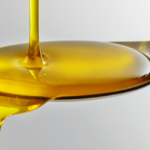Fat Consumption – Raw Data

Between 1910 and 1980, many changes took place in the kinds and amounts of fats and oils that people ate.
Total consumption of all fats increased by 35%. Our total fat consumption rose from 32% of daily calories to 42%. Fat consumption in an increasingly large, fitness-conscious part of the population is slowly declining. The average daily fat consumption in Western countries ranges between 140 and 170 grams (5 and 6 ounces) per person.
Fats and oils (shortening, margarine, refined salad and cooking oils) account for 57%, dairy products account for 7%, and meat, poultry and fish account for 31% of the total increase in our fat consumption.
In 1911, the first shortening made by hydrogenating oils appeared on supermarket shelves. The average intake of trans- fatty acids in hydrogenated products rose from zero in 1910 to close to 10% of all fats we consume today, or between 10 and 15 grams (0.5 ounce) per person per day.

Our vegetable fat consumption increased from 21 to 70 grams per day, while our consumption of animal fat decreased slightly, from 104 to 99 grams per day.
Our consumption of beef increased, while that of pork, especially since 1947, decreased. Poultry consumption rose, and poultry fat content increased. The use of fish remained essentially stable, and the use of other meats diminished.
Our use of butter declined to 1/5 of its 1910 level, while our use of margarine increased by 9 times. The use of lard went down to about 1/5 of its former level, while the use of vegetable shortenings almost doubled in the same time span. Our consumption of edible beef fat went up 2.5 times. Our consumption of salad and cooking oils increased by about 12 times.
Consumption of whole milk is less than 1/2 of its level in 1910, consumption of cream is less than 1/3 of its 1910 level, but cheese consumption has almost tripled, ice cream and frozen desserts consumption has increased 5 times, and low-fat milk consumption has increased by a factor of 3.
Our annual consumption of sugar rose from 15 pounds per person in 1815 to about 90 pounds in 1910, about 120 pounds in 1980, and about 152 pounds today. Cholesterol intake from foods has remained essentially constant during the last 70 years.
Our consumption of saturated fatty acids increased 16%, consumption of oleic acid (18:1w9) went up by 33%, and consumption of linoleic acid (LA, 18:2w6) increased by 170%.
The consumption of w3s (ALA, EPA, DHA) decreased to 1/6 of its level in 1850, while w6 (LA, AA) consumption doubled during that time, resulting in widespread w3 deficiency and serious w3:w6 imbalance.
Men consume more fat than women, but not a lot more.





